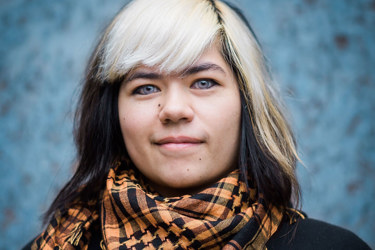
After moving between places all her life, Idris Grey MacChruiteir’s ambition was to tell impactful stories in some way – and decided game development was the perfect medium.
Idris talks to us about the concept of home, where she looks to for inspiration and her approach to quest design at Guerrilla.
Hi Idris – happy new year! We’re so excited to kick off the first Guerrilla Spotlight of 2023 with you. Let’s start with your journey before Guerrilla – where were you before you started here?
“Where are you from” is the tip of an iceberg for me, ha! As a kid, I moved between Germany and the United States a few times, so I don’t really feel like I have a ‘hometown’ - but the short answer I give nowadays is that I’m from Seattle, since that’s where I lived just before emigrating. Seattle was where I began my game dev journey in earnest, in one of DigiPen’s earliest ‘game design’ graduating classes, and also where I landed my first jobs in gaming.
What was it like growing up between the US and Germany?
Not to get too poetic, but ‘home’ is such a strange concept because what is ‘home’, really? Is it where you were born? Where you’ve spent the most time in your life? Is it a place, or is it an intangible concept, some arcane combination of people you love and familiar sights and streets?
Growing up, there wasn’t really ever a time where I felt ‘at home’; there was always some line of separation that seemed to put me in the ‘Other’ category. After many years abroad, I asked my mom if we could move back to America, because I hoped I’d feel like I fit in there - but once we’d been back for a few years, I felt just as foreign as I had living in Germany.
Wow – with that feeling you had, what made you decide to move to Amsterdam?
By the time I got to college, I was already deeply nostalgic for Europe, clinging to some hope that going back to Germany would give me the sense of place and belonging that I wanted to feel so badly. That was a huge motivator for me to look for jobs overseas, and ultimately led to me applying at Guerrilla.
(I think ‘home’ might be wherever I decide it should be, and there’s something freeing about that.)
And how do you find life in Amsterdam? What made you want to stay here?
I’d been to Amsterdam once before as a kid, but didn’t remember much about it. Having lived here for just over 5 years now, I can definitely say that I love this city. There’s something so magical and beautiful about Amsterdam in the springtime when the sun starts to linger and everything is blooming. I have a lot of fond memories of biking home late at night, feeling the energy of the city buzzing around me and through me.
As a North American who never learned to drive, living here has afforded me freedom of movement that I’d never experienced before. Between cycling and public transit, you can go basically anywhere, anytime. My moving here also happened to jumpstart a pretty significant shift in my personal life. Between that and feeling secure and invested in at work, I feel like I’ve really come into my own in the past several years. Amsterdam and Guerrilla will always be special to me for that reason. It’s a beautiful city, and it has a lot of emotional meaning for me. I’m at least three times more myself now than I was when I first moved here.
You moved around so much, which must’ve given you a diverse viewpoint of the world. As you were growing up and moving around, what led you to pursue game development?
I didn’t always know I’d pursue game dev as a career; I always knew I wanted to tell stories in some format, but was stuck deciding on a medium as I got closer and closer to my college years.
In my junior year of high school, I had a bit of a revelatory moment while finishing God of War 2. That trilogy meant a lot to me, as a teen who felt like their life was largely out of their own control. Something about seeing Kratos take down obstacles that were both figuratively and metaphorically much larger than him felt intensely cathartic.
God of War 2 ends on a cliffhanger with Kratos atop Gaia’s back, ascending Olympus to carve a path to Zeus. That moment made me feel so many things at once: excited, nervous, powerful. My very next thought was, ‘I want to make art like this – I want to make people feel, viscerally, like this.’ So I started looking into game development, found DigiPen, and sauntered down the path that eventually led me here.
That’s an amazing game developer origin story! What sparked your interest in quest design, specifically?
Like I mentioned earlier, ‘story’ has always been at the forefront of my mind - or more specifically, creating experiences for people that elicit emotion. I want to tell stories that resonate with people for years after they’ve put them on the shelf, stories that they can revisit in moments of joy or despair for the comfort or catharsis they bring.
What interests me most about game design is how we can translate emotion and story beats into gameplay: how we adapt them into mechanics that make it easier for the player to feel what the protagonist is feeling. That probably falls most cleanly under the ‘narrative design’ umbrella, which applies directly to what we do as Quest Designers at Guerrilla.
That leads us perfectly to the next question. I’m sure “game design” may sound quite abstract to a lot of people, especially since there are so many specific things you can do. How would you describe quest design to people?
Quest design is a pretty varied position! The usual reaction when describing quest design to other designers is that most AAA studios will divide the same kinds of work into two separate positions, ‘missions design’ and ‘level design’ (exact titles depend on your studio). I think there are both pros and cons to that approach vs. Guerrilla’s, but ultimately I think Guerrilla’s is the better fit for me.
Why is that? What does a Quest Designer do at Guerrilla?
First of all - and I swear I’m saying this of my own volition - I loooooooove my job. For me, the ideal position is one where I’m not doing the exact same thing every day, and where I can blend creativity and technical application; that’s exactly what we do in Quest.
Broadly speaking, Quest Designers work very closely with the Narrative team to craft experiences that are both narratively and mechanically satisfying. A Quest Designer will usually ‘own’ a quest from start to finish.
This means pitching and workshopping ideas; refining the gameplay beats in tandem with Narrative; building out the quest in-game, which includes tasks like creating combat encounters and setting up the sequence networks for our NPC conversations; then continuing to polish the quest for the duration of development.
Although we probably work most closely with the Narrative team, as Questies we need to communicate with almost every other department in order to do our job. On any given day we might discuss layout with environment and lighting artists; review an encounter with combat design to ensure it plays well and is utilizing AI well; ask tech/core design for support with a systemic interaction; support the conversations and cinematics team with their work integrating scenes into our quest; and so on.
If you don’t like to do the exact same thing every day, then all of that sounds perfect for you. I’m sure a lot of people would love to hear about the quests you worked on for Horizon Forbidden West – can you tell us about some of them?
I did work on a handful of quests in Horizon Forbidden West, but my most noteworthy contribution was the Base. A couple hours into the main questline, you unlock a facility that Aloy periodically revisits, where her companions assemble throughout the game.
As the designer for the Base, I worked on defining the layout and contents, again collaborating very closely with other departments to bring that space to life. It’s made me very, very happy to see people doing fanart of the ‘GAIA gang’, and sharing their headcanons for what goes on there while Aloy is away. Deepening Aloy’s relationships with NPCs was the task I dreamed of doing after playing through Horizon Zero Dawn, and I’m really grateful I had a chance to contribute to that in the sequel.
As always, there were features we pitched that didn’t make it into the final product - but the interactive, self-reflection objects in Aloy’s room (i.e. Fashav’s token), and the concept for the Base having a metanarrative (which Narrative fleshed out via Ethan Reed) were two concepts we were able to implement.
As a gamer yourself, are there elements of your work that are inspired by other games?
I’m guilty of taking every possible opportunity to reference Supergiant’s games. They have such a solid handle on how to create games where every aspect of the experience feeds into the others; Transistor remains my favorite game of all time.
Aside from that, I’m always interested in finding new narrative-driven experiences and dissecting how other devs translate story into mechanics. A coworker recently recommended Sayonara Wild Hearts to me, and that game is a smorgasbord of sensation and feeling.
What about things outside of games as inspiration?
I do think that game devs can be a bit guilty of getting too industry-referential when it comes to inspiration. In my opinion, strictly referencing other video games is very limiting. Life is a weird, expansive thing, and there’s plenty of aspects of it that we have yet to artfully portray through video games. Broadening our interests outside of our field to other entertainment media, like cinema and music, but also seemingly unrelated experiences, like sports or cooking, will enable us to bring fresher perspectives to the content we create.
Personally, digging into hobbies like Lindy Hop and music has allowed me to draw even more connections to my work, so I highly recommend getting out there and looking for inspiration elsewhere, too!
Quest Design sounds like a fantastic, thoughtful discipline. After reading this, if someone was interested in doing what you do, what would be your advice for them about thinking like a Quest Designer?
In my opinion, the most important aspect of design in general is shifting your lens from ‘consumer’ to ‘designer’. When you’re playing a game and have a strong internal reaction to something, don’t leave it at "That was fun", or "This sucks". Dig deeper and identify the root of those thoughts. "That boss fight was frustrating" might translate to "I felt underpowered because the encounter didn’t provide options for my favorite/familiar playstyle", or "Their attacks were telegraphed in a confusing way, so I was never sure whether I should dodge or block". Start thinking about how you sometimes "just know where to go", even in levels you’ve never been to before - or how spaces will backtrack you as needed.
Watch GDC talks from developers you admire, or check out series like Extra Credits on YouTube. Once you’re in a design mindset, you’ll start analyzing games automatically… so be aware it’s not something you’ll be able to turn off very easily!
Fantastic advice! What resources or work should future Quest Designers do to prepare for the road ahead?
Besides the perspective shift, one nice thing about the current day and age is that game development tools are more accessible than they’ve ever been. Digging into free-to-download game engines and familiarizing yourself with what it takes to actually get pixels moving around on-screen is a great first step. Once you have that down, you can focus on the much-harder ask of how to make that compelling/fun.
For designers, especially new designers, your portfolio is going to be crucial when it comes to finding work; having demonstrable, physical evidence that you can prototype in an engine will definitely help you get your foot in the door.
If you know what you want to specialize in, try to focus on the projects you make. My student projects have always been very narrative-focused, and I did the extra work to get an English minor to further refine my skillset!



